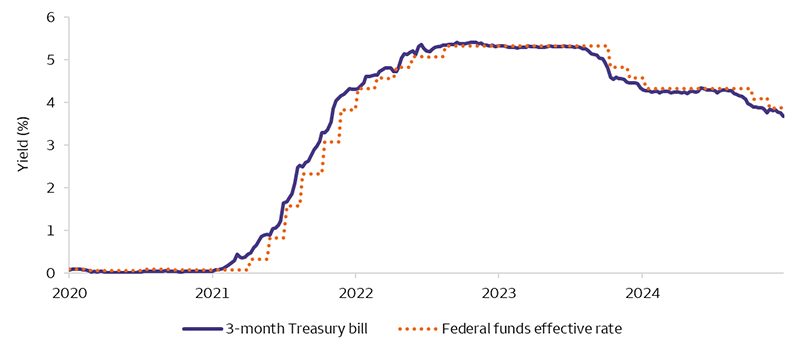December 16, 2025
Tony Miano, CFA, CAIA, Investment Strategy Analyst
Fed rate cuts shift landscape for short-term bonds
 Source: Bloomberg, data from December 14, 2020, to December 8, 2025. . Current yields may be higher or lower than illustrated. Past performance is no guarantee of future results. Excerpted from Investment Strategy report (December 15)
Source: Bloomberg, data from December 14, 2020, to December 8, 2025. . Current yields may be higher or lower than illustrated. Past performance is no guarantee of future results. Excerpted from Investment Strategy report (December 15)Ultra-short yields have fallen from recent highs amid Federal Reserve (Fed) rate cuts
Money market funds and ultra short-term fixed income investments have been a popular place to park capital for the past several years as yields increased to historically elevated levels. However, we believe that falling interest rates have and will continue to impact the attractiveness of ultra short-term assets.
The chart above shows that as a result of the Fed’s efforts to fight inflation in 2022 and 2023, investors saw yields north of 5% in these ultra short-term investments with relatively little risk. However, the chart also demonstrates that yields at this level have not been the norm in recent history. Most importantly, these yields have already come down significantly as the Fed has moved to ease rates, most recently during its December meeting.
What it may mean for investors
We believe the Fed is poised to keep cutting rates and think investors should be repositioning their ultra short-term and short-term investments, moving into longer-maturity fixed income before rates fall further. We are favorable on U.S. Intermediate Term Taxable Fixed Income (in the three- to seven-year maturity range), which we believe to be a good mix of risk and yields while allowing investors to considering locking in current yields through expected further rate cuts.
Risk Considerations
Each asset class has its own risk and return characteristics. The level of risk associated with a particular investment or asset class generally correlates with the level of return the investment or asset class might achieve. Bonds are subject to market, interest rate, price, credit/default, liquidity, inflation and other risks. Prices tend to be inversely affected by changes in interest rates.
General Disclosures
Global Investment Strategy (GIS) is a division of Wells Fargo Investment Institute, Inc. (WFII). WFII is a registered investment adviser and wholly owned subsidiary of Wells Fargo Bank, N.A., a bank affiliate of Wells Fargo & Company.
The information in this report was prepared by Global Investment Strategy. Opinions represent GIS’ opinion as of the date of this report and are for general information purposes only and are not intended to predict or guarantee the future performance of any individual security, market sector or the markets generally. GIS does not undertake to advise you of any change in its opinions or the information contained in this report. Wells Fargo & Company affiliates may issue reports or have opinions that are inconsistent with, and reach different conclusions from, this report.
The information contained herein constitutes general information and is not directed to, designed for, or individually tailored to, any particular investor or potential investor. This report is not intended to be a client-specific suitability or best interest analysis or recommendation, an offer to participate in any investment, or a recommendation to buy, hold or sell securities. Do not use this report as the sole basis for investment decisions. Do not select an asset class or investment product based on performance alone. Consider all relevant information, including your existing portfolio, investment objectives, risk tolerance, liquidity needs and investment time horizon. The material contained herein has been prepared from sources and data we believe to be reliable but we make no guarantee to its accuracy or completeness.
Wells Fargo Advisors is registered with the U.S. Securities and Exchange Commission and the Financial Industry Regulatory Authority, but is not licensed or registered with any financial services regulatory authority outside of the U.S. Non-U.S. residents who maintain U.S.-based financial services account(s) with Wells Fargo Advisors may not be afforded certain protections conferred by legislation and regulations in their country of residence in respect of any investments, investment transactions or communications made with Wells Fargo Advisors.
Wells Fargo Advisors is a trade name used by Wells Fargo Clearing Services, LLC and Wells Fargo Advisors Financial Network, LLC, Members SIPC, separate registered broker-dealers and non-bank affiliates of Wells Fargo & Company.


